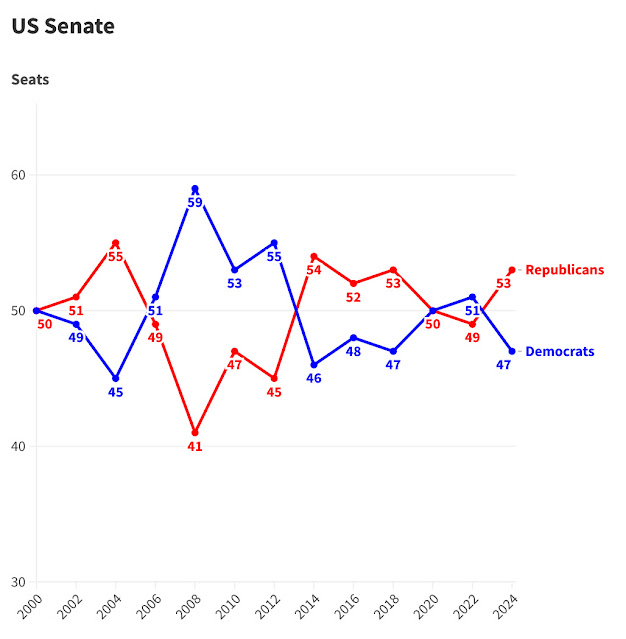This article is the second in a series about the results of the 2024 general election. The first article discussed the results of elections for the House of Representatives.
After the 2024 elections, there are 53 Republicans and 47 Democrats in the US Senate.
The Democratic total includes Bernie Sanders and Angus King, two Independents who caucus with the Democrats.
Here is a visualization showing the number of seats held by Republicans and Democrats in the Senate.
I created the visualization using flourish, a website that allows users to create compelling visual aids.
Prior to the
2024 elections, there were 51 Democrats and 49 Republicans in the Senate.
Republicans flipped four Senate seats in 2024: West Virginia, Montana, Ohio, and Pennsylvania.
Democrats didn’t flip any Senate seats in 2024.
Closest Races
The following table shows the closest 2024 races. It also includes West Virginia, which wasn’t remotely close, because it was one of the four states Republicans flipped.
The table lists the candidates, the 2024 margin by both percent and votes cast, whether the state flipped, and the 2018 margin in the state.
The margin swing shows which party performed better in 2024 compared to 2018, and by how much.
Incumbents are represented by “(i)”.
This table is organized by the 2024 margin, with the closest contests listed first.
The table is color coded, with different shades used to indicate which margins are smaller or larger than 10%.
There were several close Senate races this year.
Pennsylvania, Michigan, and Wisconsin were all decided by less than 1%.
Nevada, Arizona, and Ohio were decided by less than 5%.
Almost all of the races in this table swung toward Republicans compared to 2018, the last time these seats were up for election.
Only two races didn’t swing toward Republicans.
In Arizona, the margin remained exactly the same, creating a margin swing of 0.
In both 2018 and 2024, the Democratic candidate won Arizona by 2.4%.
In Nebraska, Independent Dan Osborn ran against Republican incumbent Deb Fischer in a one-on-one race, after Democrats chose not to nominate a candidate.
Osborn reduced Fischer’s margin of victory in 2024 by 12.4% compared to what it had been in 2018.
Fischer still won by 6.7%, but Nebraska was the only Senate seat, at least among the closest elections, where the margin of victory shifted away from Republicans, compared to 2018.
If Kamala Harris had managed to win the presidential election, Nebraska would have been the tipping point state for Senate control.
Because Donald Trump won the presidential election, Montana was the tipping point election for Senate control.
The largest swing toward Republicans, among the races listed here, was in West Virginia, where Republicans performed 44.3% better than they did in 2018.
Incumbent Joe Manchin, who was elected in 2018 as a Democrat, chose not to run for reelection.
Republican Jim Justice ran for the West Virginia Senate seat in 2024, while he was the state's sitting governor. He won by a margin of 41%, in a landslide victory.
Other large swings toward Republicans took place in Maryland, New Mexico, Pennsylvania, and Florida.
This map shows the results of the 2024 US Senate elections.
I created the map using mapchart.net.
Republicans won by less than 10% in Pennsylvania, Ohio, Nebraska, Montana, and Texas.
Democrats won by less than 10% in Michigan, Wisconsin, Nevada, Arizona, Virginia, and New Jersey.
States Democrats won by more than 10% are shown in dark blue.
States Republicans won by more than 10% are shown in dark red.
The two Independent candidates, who caucus with the Democrats, were up for reelection this year. They both won reelection by more than 10%. Their states are shown in dark green.
Like the table above, the table below shows the 2018 and 2024 margins in key Senate races, but this table is organized by the 2018 margin.
The table uses two shades of blue and two shades of red to differentiate between values greater and less than 10%.
The table contains all regularly scheduled races from 2018 that were decided by less than 10%. It also includes other races that were considered competitive prior to the 2024 election.
Nebraska remains the only Senate election where anyone gained ground against Republicans, compared to 2018.
I find it striking Republicans were able to flip Pennsylvania, even though Bob Casey Jr. won the state in 2018 by 13%.
Historical context
This table lists the Senate seats held by Democrats and Republicans after each election since 2000.
I created the table using information from Wikipedia.
Independents who align with Democrats are counted as Democrats.
Tracking partisan control of the Senate isn’t possible without doing so.
Ties in the Senate are broken by the Vice President, which gives majority control of a 50-50 Senate to the party that won the most recent presidential race.
Dick Cheney broke a tie to give Republicans Senate control after the 2000 election.
Kamala Harris broke a tie to give Democrats Senate control after the 2020 election.
Since 2000, Republicans have controlled the Senate after seven elections, and Democrats have controlled the Senate after six elections.
That is as close to an even split as you can have for an odd number.
Here are what these values look like on a line graph.
The graph was created using flourish.
The largest majority on the graph was after the 2008 election, when Democrats held 59 seats.
There were two times where a party held 55 seats.
Republicans held 55 seats after the 2004 election, and Democrats held 55 seats after the 2012 election.
In the next article, we’ll grade my Senate predictions, and examine the accuracy of polling for the Senate contests.
@2x.jpeg)

@2x.jpeg)





No comments:
Post a Comment